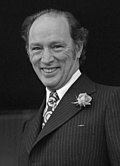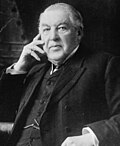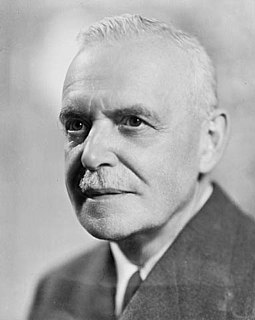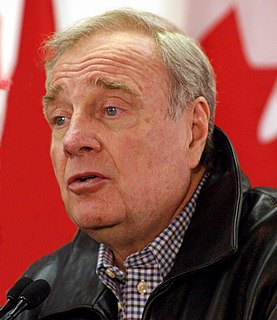| Prime Minister | Total time in office | Dates in office | Number of governments | Comments |
|---|
|
| 1 | 
William Lyon Mackenzie King | 21 years, 154 days [3] A | 1921-12-29 to 1926-06-28 [20] 1926-09-25 to 1930-08-06 [20] 1935-10-23 to 1948-11-14 [20] | Six governments in total.
Three majority governments:
1921–1925 [21]
1935–1940 [22]
1940–1945 [23]
Three minority governments:
1925–1926 [24]
1926–1930 [25]
1945–1948 [26] | King served three non-consecutive terms: from 1921 to the spring of 1926 (one majority and one minority government); from the fall of 1926 to 1930 (minority government); and from 1935 to 1948 (two majority governments and one minority government).
First term: King began his first term after winning a narrow majority government in the election of 1921, defeating Prime Minister Meighen. His government fluctuated between majority and minority over the course of four years, due to by-elections and political developments. He won a minority government in the 1925 election, but that government was cut short by the King-Byng Affair. To avoid a motion of censure in the Commons, King asked the Governor General, Viscount Byng to call an election. The Governor General refused and King resigned. The Governor General appointed Meighen as prime minister, but Meighen's government fell after only four days in office, triggering a general election, which King won. [27]
Second term: King began his second term when he won a minority government in the 1926 election. [28] His second term lasted until 1930, when he was defeated by R.B. Bennett in the 1930 general election and resigned as prime minister. He stayed on as party leader and became Leader of the Opposition. [29]
Third term: King began his third and longest term when he won the election of 1935, defeating Prime Minister Bennett and winning a majority government. [30] He won the subsequent elections in 1940 and 1945, and retired in 1948. [31] He was succeeded by Louis St. Laurent. [32] |
|
| 2 | 
Sir John A. Macdonald | 18 years, 359 days [3] B | 1867-07-01 to 1873-11-05 [4] 1878-10-17 to 1891-06-06 [4] | Six majority governments: 1867–1872 [33]
1872–1873 [34]
1878–1882 [35]
1882–1887 [36]
1887–1891 [37]
1891 [38] | Macdonald served two non-consecutive terms: from July 1, 1867 to the fall of 1873 (two majority governments), and from 1878 until his death in 1891 (four majority governments).
First term: The Governor-General, Viscount Monck, appointed Macdonald the first prime minister of Canada on July 1, 1867 [39] prior to the first general election, which Macdonald won. His second government, elected in 1872, was cut short by the Pacific Scandal. When it became apparent that he had lost the confidence of the Commons in the fall of 1873, Macdonald resigned as prime minister, remaining party leader and becoming Leader of the Opposition. The Governor-General, the Earl of Dufferin, appointed Alexander Mackenzie as prime minister. [40]
Mackenzie then called the general election of 1874, which he won.
Second term: Returned to power after defeating Prime Minister Mackenzie in the election of 1878, Macdonald won four successive majority governments. His last government, elected in April, 1891, ended upon his death on June 6, 1891. [41] The office of prime minister was vacant for ten days from Macdonald's death on June 6, 1891, until the appointment of Sir John Abbott as prime minister on June 16, 1891. [3] After Abbott, three other individuals served in turn as prime minister until the next election in 1896. [42] [43] |
|
| 3 | 
Pierre Trudeau | 15 years, 164 days [3] C | 1968-04-20 to 1979-06-03 [18] 1980-03-03 to 1984-06-29 [18] | Four governments in total. Three majority governments: 1968–1972 [44]
1974–1979 [45]
1980–1984 [46] One minority government: 1972–1974 [47] | Trudeau served two non-consecutive terms: from 1968 to 1979 (two majority governments and one minority government), and then from 1980 to 1984 (one majority government).
First term: When Prime Minister Pearson retired, Trudeau won the Liberal leadership and became Prime Minister on April 20, 1968. [48] [18] He called a general election for June 25, 1968, winning a majority government. He remained in office for two more elections, but was defeated by Joe Clark in the 1979 election. Trudeau resigned the leadership of the Liberal Party and announced his retirement from politics, staying on as interim leader until the Liberals elected a new party leader. [13]
Second term: In the first session of the new parliament it became clear that Clark's government was quickly losing popular support. The Liberals and the New Democratic Party combined to defeat the budget of the Clark government. Since that was a confidence matter, Clark was forced to call an election. Trudeau resumed the leadership of the Liberal Party and defeated Prime Minister Clark in the 1980 election. [13] He stayed in office until 1984, when he announced his retirement after taking a walk in the snow. [49] He was succeeded by John Turner. [50] |
|
| 4 | 
Sir Wilfrid Laurier | 15 years, 86 days [3] | 1896-07-11 to 1911-10-06 [51] | Four majority governments: 1896–1900 [52]
1900–1904 [53]
1904–1908 [54]
1908–1911 [55] | Laurier served one continuous term of fifteen years, the longest uninterrupted term of any prime minister. He took office after defeating Prime Minister Tupper in the general election of 1896. During his term, he won four majority governments. He was defeated by Robert Borden in the 1911 general election and resigned. [56] [57] |
|
| 5 | 
Jean Chrétien | 10 years, 38 days [3] | 1993-11-04 to 2003-12-11 [58] | Three majority governments: 1993–1997 [59]
1997–2000 [60] 2001–2003 [61] | Chrétien served for one term, winning three majority governments. He took office after defeating Prime Minister Campbell in the 1993 general election and stayed in power for ten years. After a leadership challenge within the Liberal Party from Paul Martin, he resigned as prime minister and leader of the Liberal Party on December 12, 2003 and was replaced by Martin. [62] [63] |
| 6 | 
Stephen Harper | 9 years, 271 days [3] | 2006-02-06 to 2015-11-03 [64] | Three governments in total.
Two minority governments:
2006–2008 [65]
2008–2011 [66]
One majority government:
2011–2015 [67] | Harper served for one term, winning two minority governments and one majority government. He took office after defeating Prime Minister Martin in the general election of 2006 and stayed in office for nine years. He was defeated by Justin Trudeau in the general election of 2015 and resigned. [68] [69] [70] |
|
| 7 | 
Brian Mulroney | 8 years, 281 days [3] | 1984-09-17 to 1993-06-24 [71] | Two majority governments: 1984–1988 [72]
1988–1993 [73] | Mulroney served one term, with two majority governments. He took office after defeating Prime Minister Turner in the 1984 general election. He won the largest number of seats in Canadian history: 211 out of 295 seats in the House of Commons. [72] He retired in 1993 and was succeeded by Kim Campbell. |
|
| 8 | 
Sir Robert Borden | 8 years, 274 days [3] | 1911-10-10 to 1917-10-11 [74] 1917-10-12 to 1920-07-09 [74] | Two majority governments: 1911–1917 [75]
1917–1921 [76] | Borden served two consecutive terms, the only prime minister to do so, as a war-time measure.
First term: Borden was elected in the 1911 general election, defeating Prime Minister Laurier and forming a majority government. [77]
Second term: During the Conscription Crisis in World War I, Borden, a Conservative, approached Laurier and the Liberals to form a coalition war-time government. Laurier refused, but a large number of Liberals joined Borden, who formed a Unionist government. [78] He was formally re-appointed as prime minister under the new government. [74] Borden stayed in office after the end of the war, resigning in 1920. He was succeeded by Arthur Meighen. [79] |
|
| 9 | 
Louis St. Laurent | 8 years, 218 days [3] | 1948-11-15 to 1957-06-20 [80] | Two majority governments: 1948–1953 [81]
1953–1957 [82] | St. Laurent served one term as prime minister, with two majority governments. After King announced his retirement in 1948, St. Laurent won the Liberal leadership [83] and became prime minister. He won the general election of 1949 and stayed in office until 1957. He was defeated by Diefenbaker in the 1957 general election and resigned. [84] [85] |
|
| 10 | 
John Diefenbaker | 5 years, 305 days [3] | 1957-06-21 to 1963-04-21 [86] | Three governments in total. Two minority governments: 1957–1958 [87]
1962–1963 [88] One majority government: 1958–1962 [89] | Diefenbaker served for one term, with two minority governments and one majority government. In the general election of 1957, Diefenbaker defeated Prime Minister St. Laurent by winning a minority government. After a short parliamentary session of less than four months, Diefenbaker called a general election in early 1958. He won the largest majority ever in Canadian history up to that time (208 seats of the 265 seats in the House of Commons). [89] However, in the subsequent election of 1962, he was reduced to a minority government, which lasted only half a year before being defeated on a confidence measure. In the 1963 election, Diefenbaker was defeated by Pearson, who won a minority government. Diefenbaker resigned as prime minister. [90] [91] |
|
| 11 | 
R. B. Bennett | 5 years, 77 days [3] | 1930-08-07 to 1935-10-22 [92] | One majority government: 1930–1935 [93] | Bennett served for one term, with one majority government. He defeated Prime Minister King in the 1930 general election, but in turn lost to King in the 1935 general election. He resigned as prime minister and retired from Canadian politics, sitting in the British House of Lords for many years. [94] [95] |
|
| 12 | 
Lester B. Pearson | 4 years, 363 days [3] | 1963-04-22 to 1968-04-19 [96] | Two minority governments: 1963–1965 [97]
1965–1968 [98] | Pearson served for one term, with two minority governments. He defeated Prime Minister Diefenbaker in the 1963 general election. [99] He maintained power, again with a minority government, in the 1965 general election. After he announced his retirement in 1968, Pierre Trudeau was elected leader of the Liberal Party [48] and succeeded him as prime minister. [100] |
|
| 13 | 
Alexander Mackenzie | 4 years, 336 days [3] | 1873-11-07 to 1878-10-08 [101] | One majority government: 1873 – 1878 [34] [102] | Mackenzie served one term, over two parliaments. He appointed prime minister in the fall of 1873 by the Governor-General, the Earl of Dufferin, after Prime Minister Macdonald resigned over the Pacific Scandal. [40] Mackenzie then called a general election early in 1874, in which he won a majority government. [103] However, he lost the next general election in 1878 to Macdonald, and resigned as prime minister. [104] [105] |
| 14 | 
Justin Trudeau (incumbent) | 3 years, 278 days [3]
As of August 9, 2019. | 2015-11-04 to present [106] | One majority government to date:
2015–present [107] | Trudeau is currently serving his first term of office, with a majority government. He took office after defeating Prime Minister Harper in the general election of 2015. [69] |
|
| 15 | 
Paul Martin | 2 years, 56 days [3] D | 2003-12-12 to 2006-02-05 [108] | One majority government: 2003–2004 [61] One minority government: 2004–2006 [109] | Martin served one term over two parliaments, initially with a majority government, then with a minority government. He became prime minister in December, 2003, as the result of a successful challenge to the leadership of Prime Minister Chrétien. [63] He inherited the 37th Parliament, in which the Liberals held a majority, and held one session in the spring of 2004. He then called the general election of 2004, in which his government was reduced to a minority. Martin's government fell on a confidence vote in late 2005, [110] forcing him to call the general election of 2006. Harper and the Conservative Party won a minority government in that election and Martin resigned as prime minister. [111] |
|
| 16 | 
Sir John Thompson | 2 years, 7 days [3] | 1892-12-05 to 1894-12-12 [5] | One majority government: 1892–1894 [38] | Thompson served one term of just over two years. He was the second prime minister to lead the Conservative government after Macdonald's death in 1891, prior to the next election in 1896. He had a majority in the parliament elected in the 1891 election, but never led his government in an election, as he died suddenly in 1894 at Windsor Castle. The office of prime minister was vacant for nine days until the Governor General, the Earl of Aberdeen, appointed Mackenzie Bowell as prime minister. [3] [112] Thompson was the second and last prime minister of Canada to die in office. [113] |
|
| 17 | 
Arthur Meighen | 1 year, 260 days [3] | 1920-07-10 to 1921-12-28 [114] 1926-06-29 to 1926-09-24 [114]
E | Two governments in total. One majority government:
1920–1921 [76] One minority government:
1926 [24] | Meighen served two short non-consecutive terms, in 1920-1921 and 1926.
First term: When Borden announced his retirement in 1920, the Conservative party caucus asked him to recommend his successor. After consulting with the individual members of caucus, he recommended that Meighen be the new party leader. The caucus accepted that recommendation and Meighen became party leader and prime minister. [115] He governed for just over a year with a majority in the parliament elected under Borden's leadership in the 1917 election, then called the general election of 1921. He was defeated by King, who won a narrow majority government. Meighen resigned as prime minister, but remained as party leader. He had lost his own seat, but was elected in a by-election and returned to Parliament in January, 1922. He served as Leader of the Opposition for the next four years. [116] [115]
Second term: Meighen served a second term of just under three months in 1926. In the 1925 election, Meighen and the Conservatives won more seats than King and the Liberals, but did not win a majority. King was able to keep governing with the support of the Progressives until he faced a motion of censure in the Commons in the spring of 1926. The Governor General refused King's request for a dissolution of Parliament and King resigned as prime minister. Governor General Byng then appointed Meighen as Prime Minister, but Meighen's government fell within four days, defeated in Parliament. The Governor General now granted the dissolution of Parliament, triggering a general election. [27] Meighen lost the 1926 election to King and again was defeated in his own riding. He resigned as prime minister for the second time. [115] |
|
| 18 | 
Sir John Abbott | 1 year, 161 days [3] | 1891-06-16 to 1892-11-24 [117] | One majority government: 1891–1892 [38] | Abbott served one short term of just over a year. Following Macdonald's death in the spring of 1891, Abbott was appointed prime minister by the Governor General, Lord Stanley, on the recommendation of the Cabinet. [118] He was the first of four prime ministers to serve after Macdonald's death and prior to the next election, in 1896. He had a majority in the parliament elected in the 1891 election, but never led his government in an election, as he retired in 1892 due to health reasons. [119] |
|
| 19 | 
Sir Mackenzie Bowell | 1 year, 128 days [3] | 1894-12-21 to 1896-04-27 [120] | One majority government: 1894–1896 [38] | Bowell served one short term of just over a year. After Thompson's sudden death in office in late 1894, Bowell was appointed prime minister by the Governor General, the Earl of Aberdeen. [15] Bowell was the third prime minister to lead the Conservative government after Macdonald's death in 1891, prior to the next election in 1896. He had a majority in the parliament elected in the 1891 election, but never led his government in an election. He resigned from office after a Cabinet revolt over his handling of the Manitoba Schools Question. |
|
| 20 | 
Joe Clark | 273 days [3] | 1979-06-04 to 1980-03-02 [121] | One minority government: 1979–1980 [122] | Joe Clark served one short term in a minority government. In office for just nine months, Clark's term was the shortest for a prime minister who won an election. Clark and the Progressive Conservatives defeated Prime Minister Pierre Trudeau and the Liberals in the 1979 general election, but only won a minority in the Commons. The popularity of the Clark government dropped sharply after the election, and in December 1979, the opposition parties, the Liberals and New Democrats, combined to defeat the government's budget. Since that was a confidence measure, Clark was forced to call an election in early 1980, which he lost to Trudeau and the Liberals. He resigned as prime minister. [13] |
|
| 21 | 
Kim Campbell | 132 days [3] | 1993-06-25 to 1993-11-03 [123] | One majority government: 1993 [73] | Campbell served one short term in 1993. After Brian Mulroney announced his resignation, Campbell won the leadership of the Progressive Conservative party [124] and became prime minister in June, 1993. She called an election shortly afterwards but was defeated in the largest electoral loss by a federal government in Canadian history, going from a majority in the thirty-fourth parliament to only two seats in the thirty-fifth parliament. Campbell lost her own seat and resigned as prime minister. [123] |
|
| 22 | 
John Turner | 79 days [3] | 1984-06-30 to 1984-09-16 [125] | One majority government: 1984 [46] | Turner served one short term as prime minister. He had come in third in the 1968 Liberal leadership convention, [48] which Pierre Trudeau won, and had served from 1968 to 1975 in Trudeau's cabinet. When Trudeau announced his retirement in early 1984, Turner re-entered politics. He won the Liberal leadership [126] and became prime minister. He called the 1984 election, which he lost to Brian Mulroney. He resigned as prime minister but stayed on as Liberal leader and Leader of the Opposition. After he lost the 1988 general election to Mulroney, he retired from politics. [125] Turner is one of three prime ministers who never sat in Parliament as prime minister, the others being Campbell and Tupper. |
|
| 23 | 
Sir Charles Tupper | 68 days [3] | 1896-05-01 to 1896-07-08 [127] | One majority government: 1896 [38] | Tupper served the shortest term of any Canadian prime minister, only 68 days. Prime Minister Bowell resigned after a cabinet revolt over his handling of the Manitoba Schools Question. Tupper, with the support of the Cabinet, was appointed prime minister by the Governor General, the Earl of Aberdeen. Tupper was the fourth and last prime minister to lead the Conservative government after Macdonald's death in 1891. He led the Conservatives into the 1896 election, which he lost to Laurier. [128] He resigned as prime minister but stayed on as leader of the Conservative party and Leader of the Opposition. He was defeated by Laurier in the 1900 election and retired from politics. [129] He was one of three prime ministers who never sat in Parliament while he was Prime Minister, the others being Campbell and Turner. |
|
















































